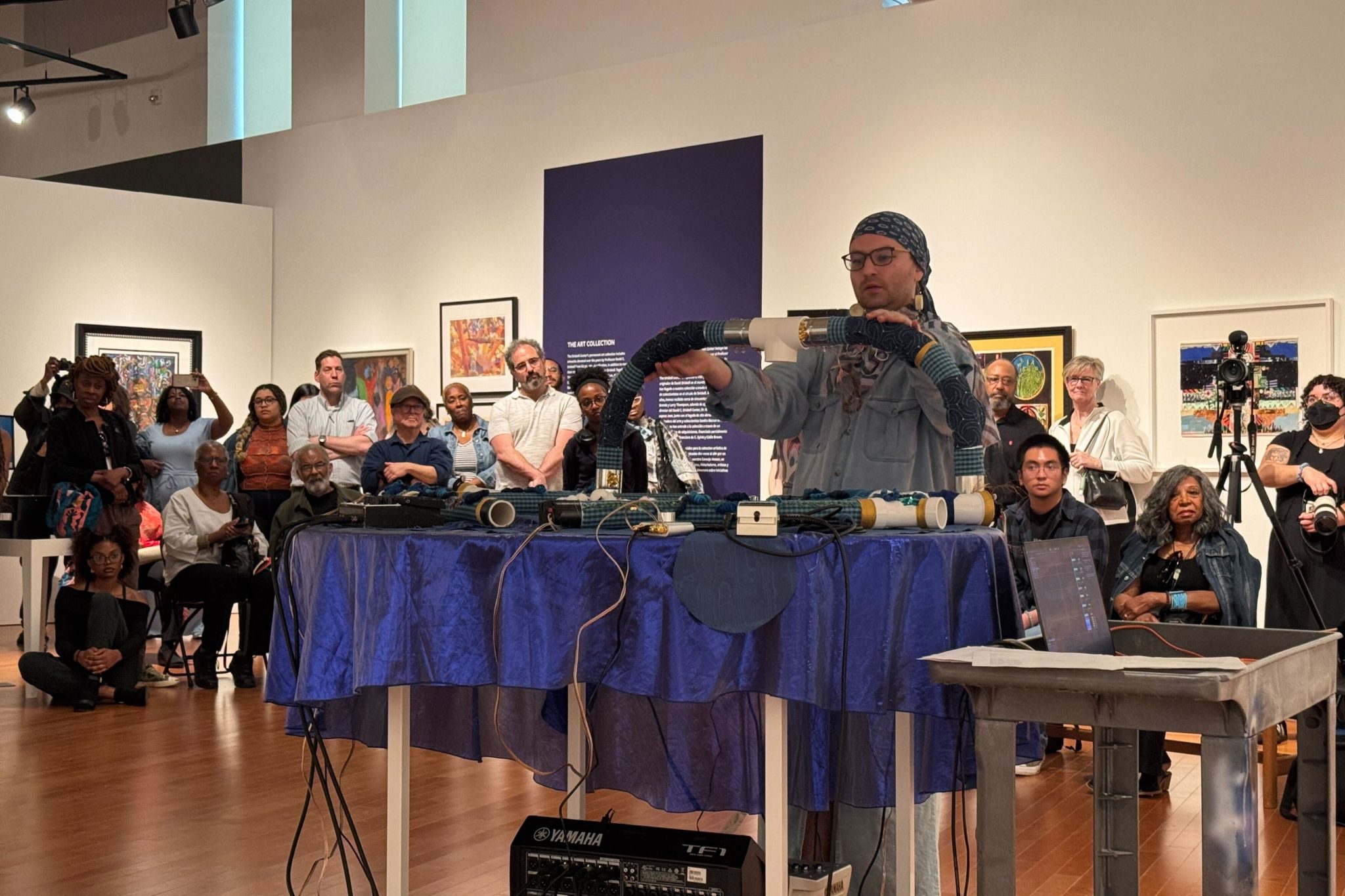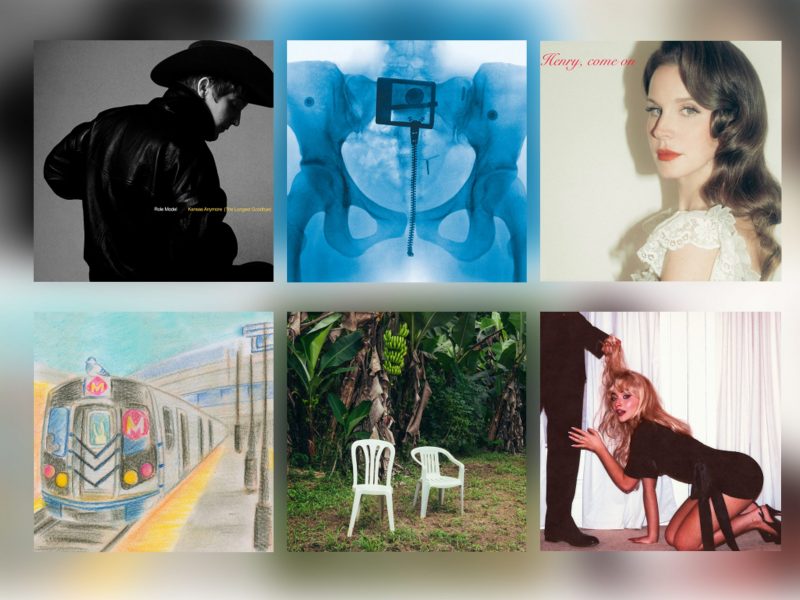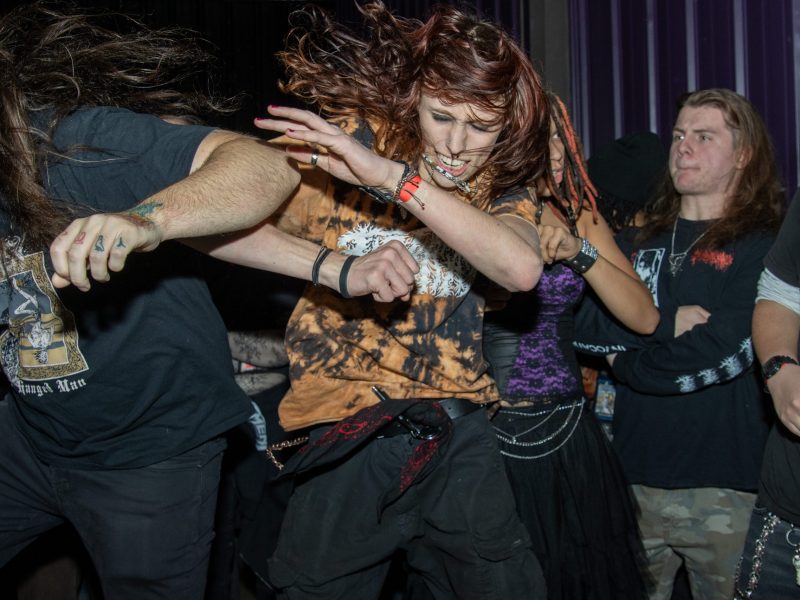Attendees of “Deity of the Circle,” which premiered Thursday at the University of Maryland’s David C. Driskell Center Gallery, received a slip of paper with a simple affirmation upon entering the space:
“Listen to your breath. What does your breathing tell you about your state of being?”
The Driskell Center’s latest installation blends cultures and artistic mediums, including video, sculpture and tapestry, to invoke themes of displacement and belonging. Interdisciplinary artists Armond Dorsey, Bonita Oliver and Eli Berman created the installation, debuting it with a 40-minute performance in the art gallery, feet away from the audience.
The three artists won the 2024-25 David C. and Thelma G. Driskell Award for Creative Excellence, which honors forward-thinking art pieces. “Deity of the Circle” is part of the Arts for All initiative, which seeks to elevate the university’s art scene.
At the heart of the production is Berman’s “vocal feedback pipes,” a combination of jutting plastic tubes and audio equipment that create a resonant echo when spoken into. These pipes formed an upward loop adorned with varying shades of blue tapestry, reminiscent of spiritual traditions from the Congo cosmogram. Berman built the structure during the performance’s interludes.
Karin Zitzewitz, chair of this university’s art history and archaeology department, attended the performance and praised the sculpture’s creativity and do-it-yourself elements.
[College Park-based band ‘The Odyssey’ turns basement jams into bold new tracks]
“It’s a really interesting choice to make it clear what the materials are and to make it homey and beautiful, while also being clearly made out of stuff you can pick out at home,” Zitzewitz said.
The sculpture alludes to Sankofa, a Ghanaian symbol of a bird that represents a return to the past, as well as the Yad, a pointer used to read the Torah.
Audience member Adé Oluokun identified with the Sankofa’s theme of reconnecting to human history.
“The notion of Sankofa is something that I live by arduously, and I think they were pretty tenacious in expressing that and making that an ardent call for everyone to follow,” Oluokun said.
The performance weaves together song and spoken word throughout the performance. Oliver sang ancestral chants, while Dorsey played the clarinet. The three performed spoken-word segments between these musical passages, outlining tales of strife and trauma.
While the performance is rooted in tradition, it also tackles present-day issues. One segment critiques the Trump administration’s attempt to censor student activists, while another references Palestinian displacement amid the Israel-Hamas war.
Audience member Mateo Lombard felt the performance encouraged the audience to look into their past to understand their future. “The main themes I got from it — from just initial thoughts right now — is that connection of regaining your past, regaining your history that is all still present within you,” Lombard said. “You just need to look back into your own self-reflection to see that those roots and those emotions are still there with you no matter how long.”
Despite addressing dark themes, the performance inspired hope to audience members. Throughout, Oliver reminds audience members to check their breathing, playing into themes of spiritual connection.
In an extended segment, the performers danced around the sculpture, inviting the audience to clap along and join their circle.
Attendee Mila Fields-Zayas, who participated in the dance, said the interaction drew her closer to both the surrounding audience and the piece itself.
[‘A Minecraft Movie’ blocks its own success with basic plot, tonal whiplash]
“Sometimes art performances can feel like you’re not part of it,” Fields-Zayas said. “And really being a part of it felt very communal and aligned with the message they were trying to set.”
As the performance closed, Berman finally completed the vocal feedback pipe structure. Reverberating chants and clarinets filled the space. The performance mirrors this moment, describing the chants as “traditions for healing trauma.”
“Deity of the Circle” is a largely interpretive work, with varying takeaways from audience members. Lombard appreciated how the performance challenged his expectations of art performance. Zitzewitz resonated with the message to keep breathing and the themes of community. Fields-Zayas, a ceramicist, connected to the themes of home and displacement, themes they explore in their own art.
Oluokun hopes the piece’s cyclical nature will inspire hope and resilience among diasporas.
“I see [the themes] as a product of alchemy, which is like, ‘yeah, this is what’s going on,’” Oluokon said. “This is not a panacea, but a way in which we can pontificate on some solutions.”



